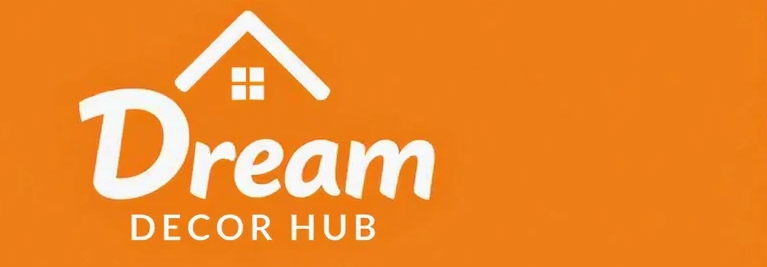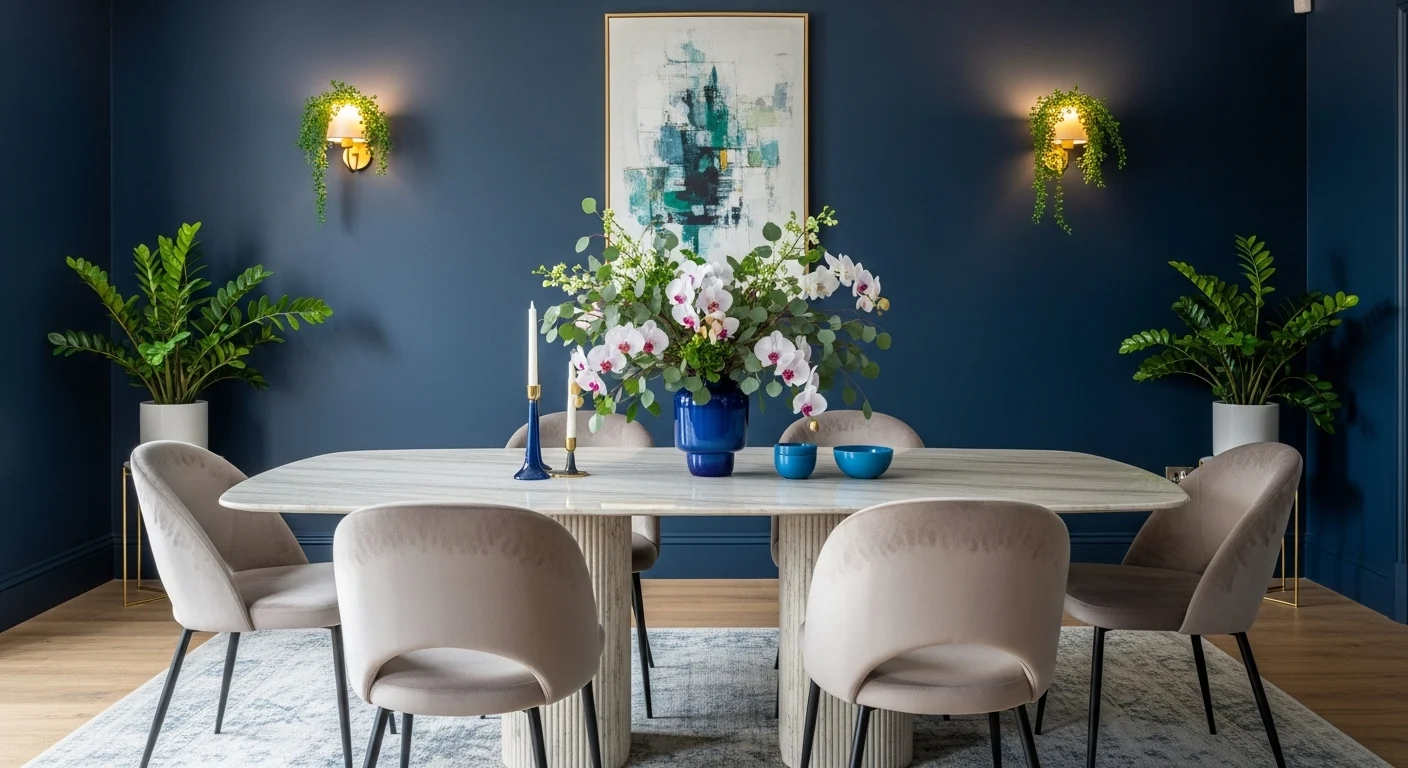So you love the idea of a blue dining room but you’re worried about creating something that feels more like a nautical-themed seafood restaurant than a sophisticated space where you’d actually want to host dinner parties. You’ve probably seen those attempts where someone just painted everything navy and threw in some anchor decorations, completely missing what makes blue dining rooms genuinely elegant.
Here’s what most people get wrong about blue dining rooms: they think you can just pick one shade of blue and call it done, or they go so bold with the color that it overwhelms everything else. But real sophistication with blue comes from layering different shades, balancing bold elements with neutrals, and using quality materials that make the color feel intentional rather than theme-y.
Whether you’re starting from scratch or trying to incorporate blue into your current dining room, these ideas will help you create something that feels both dramatic and genuinely livable—the kind of space that makes every meal feel like an occasion.
Understanding What Makes Blue Dining Rooms Work
Before diving into specific approaches, let’s talk about what separates sophisticated blue dining rooms from ones that feel overwhelming or costume-y.
Layer Different Blues for Depth – The best blue dining rooms don’t use just one shade. They layer navy, dusty blue, teal, or powder blue to create richness and visual interest.
Balance Bold with Neutral – Blue is powerful, so you need breathing room. Neutrals in furniture, flooring, or other walls prevent the blue from feeling suffocating.
Quality Materials Matter More – In a dramatic color scheme, cheap materials stand out even more. Investment pieces make the difference between elegant and trying-too-hard.
15 Blue Dining Room Ideas
1. Create Depth Through Layered Blue Shades
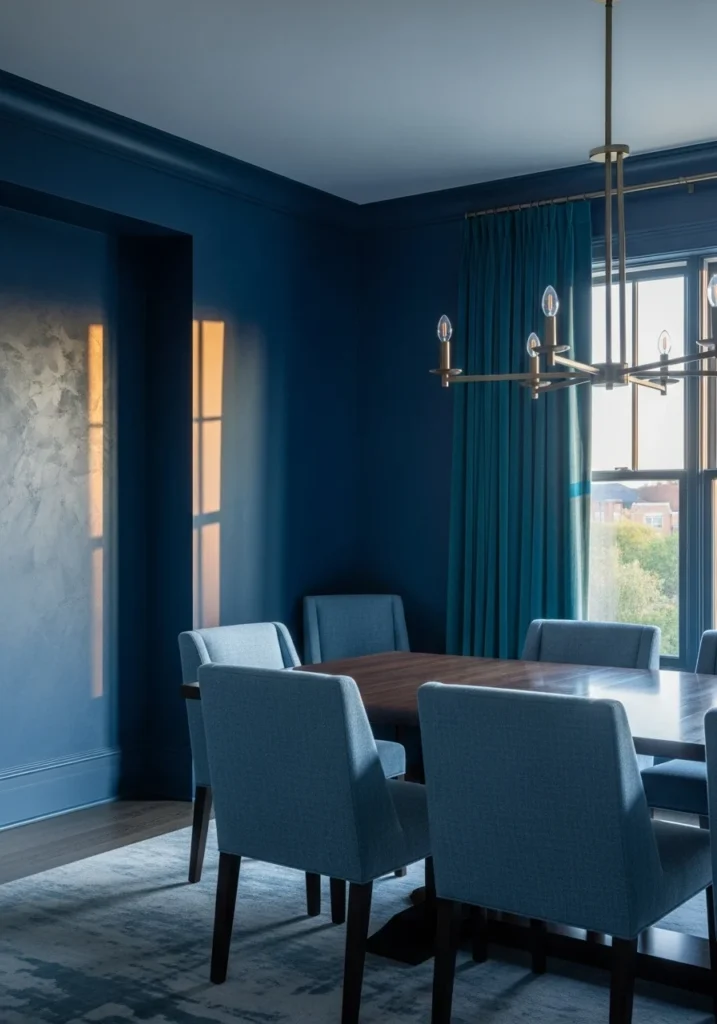
Use deep navy Venetian plaster on walls, layer with dusty blue upholstered chairs and teal velvet drapes for sophisticated gradient depth. Pair with sleek dark wood tables and brushed brass chandeliers.
The key is varying your blue tones—not everything the same shade. This creates richness and prevents the space from feeling flat or one-note.
2. Make Your Table the Sculptural Focus
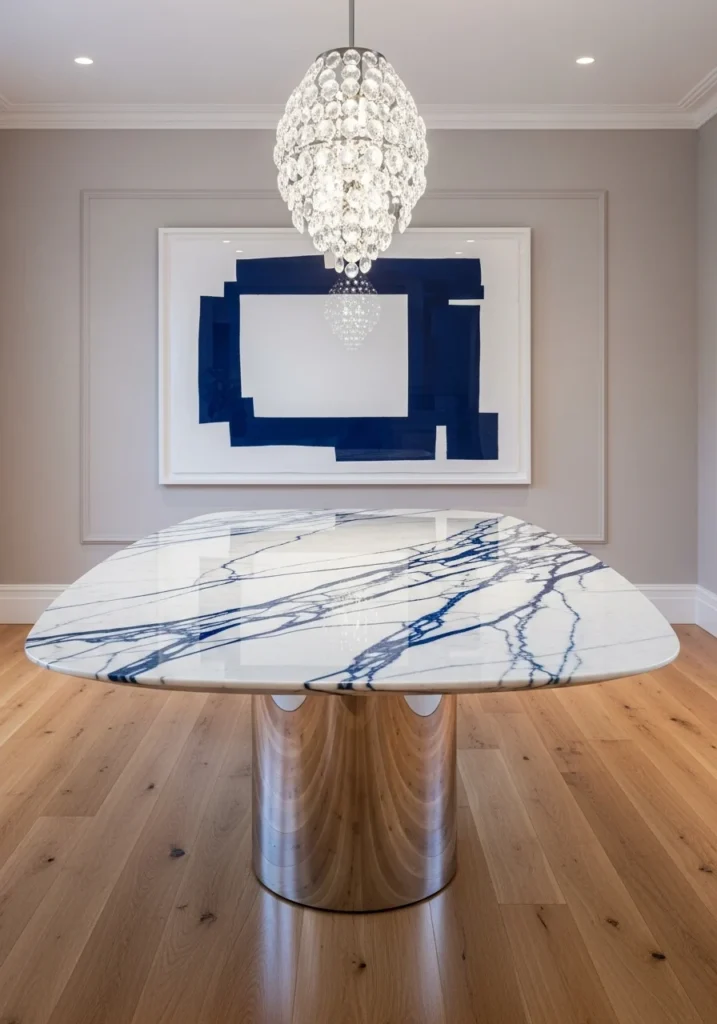
Choose a bold sculptural marble table with white base and blue veining as your centerpiece. Surround with soft neutral walls and navy accent art, letting the table be the star.
Overhead crystal pendants catch highlights beautifully against polished oak floors. When your table is this special, everything else can stay relatively simple.
3. Add Luxury Through Velvet Upholstered Chairs
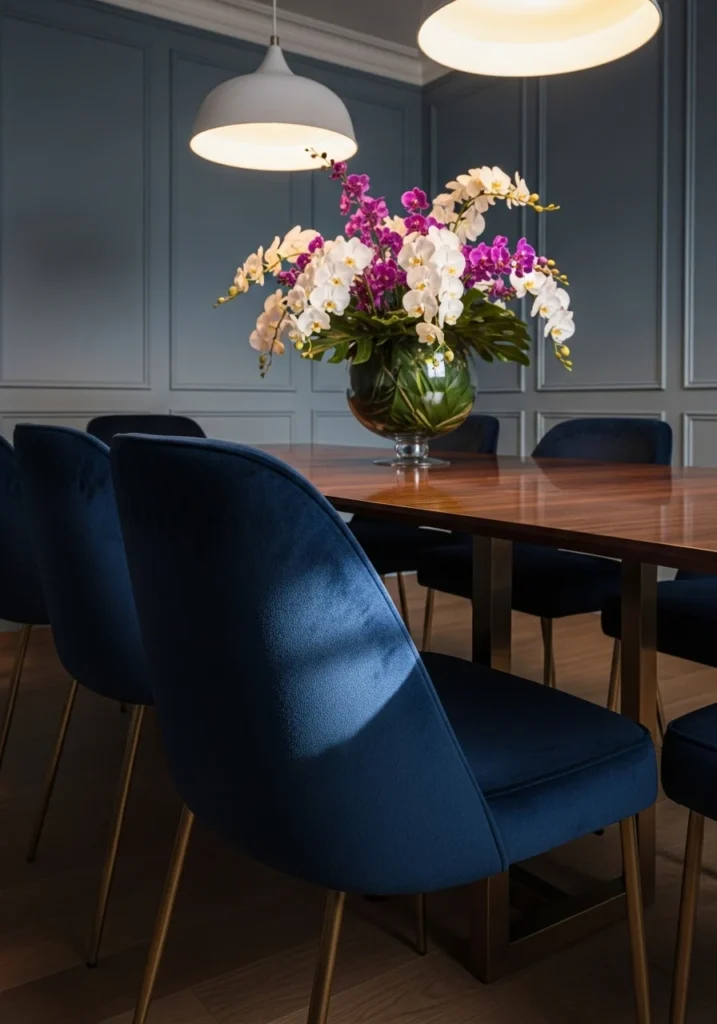
Use navy velvet dining chairs with slim brass frames around walnut tables for tactile richness. Pair with muted dusty blue wall paneling and oversized glass vase centerpieces.
The velvet texture makes blue feel luxurious rather than flat, while brass frames add that necessary metallic warmth that prevents the space from feeling cold.
4. Create Drama With Statement Lighting
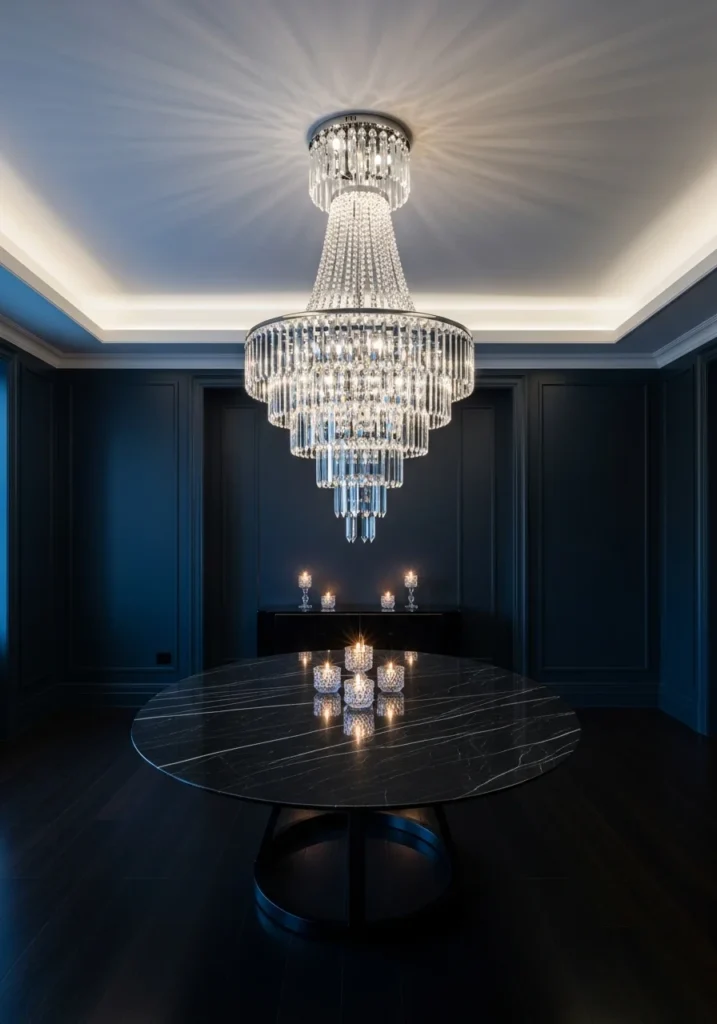
Install dramatic crystal chandeliers cascading over round black marble dining tables against midnight blue walls. White ceilings with recessed uplighting and reflective dark floors amplify the drama.
The lighting becomes jewelry for the room—choose something substantial enough to hold its own against bold wall colors.
5. Balance Blue With Strategic Metallic Accents
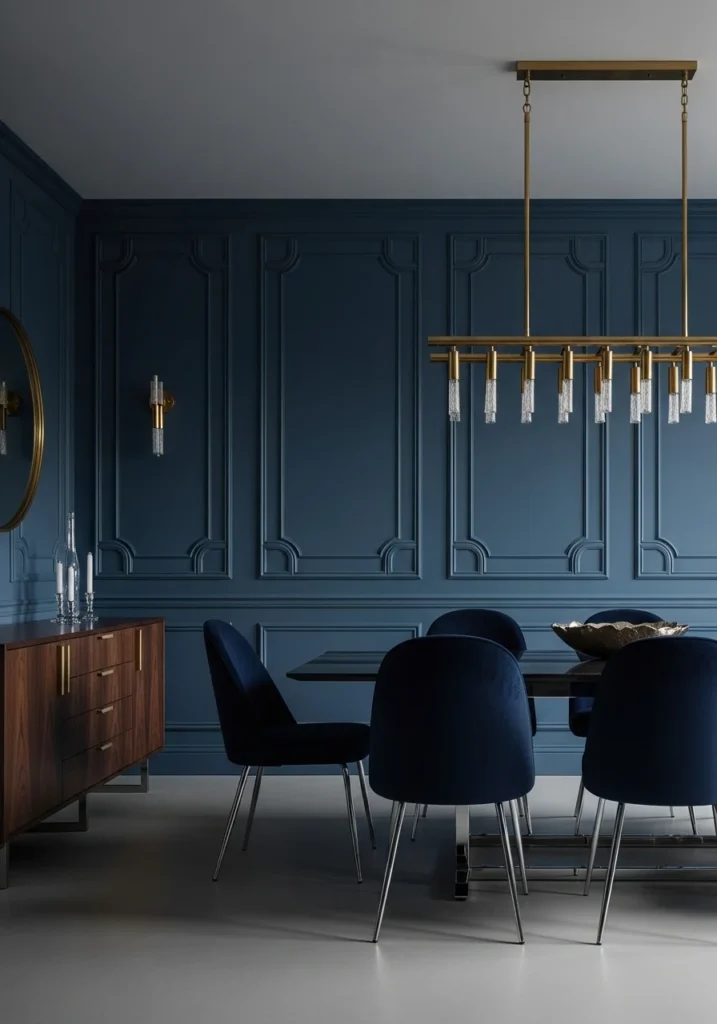
Use cobalt-blue lacquered walls with inset brass trim, navy velvet chairs with polished chrome legs, and statement linear brass chandeliers overhead.
The mix of brass and chrome creates visual interest while the metallics provide necessary contrast and warmth against saturated blue backgrounds.
Also Read: How to Style a Warm Neutral Kitchen That Actually Feels Inviting
6. Make Art Your Blue Statement
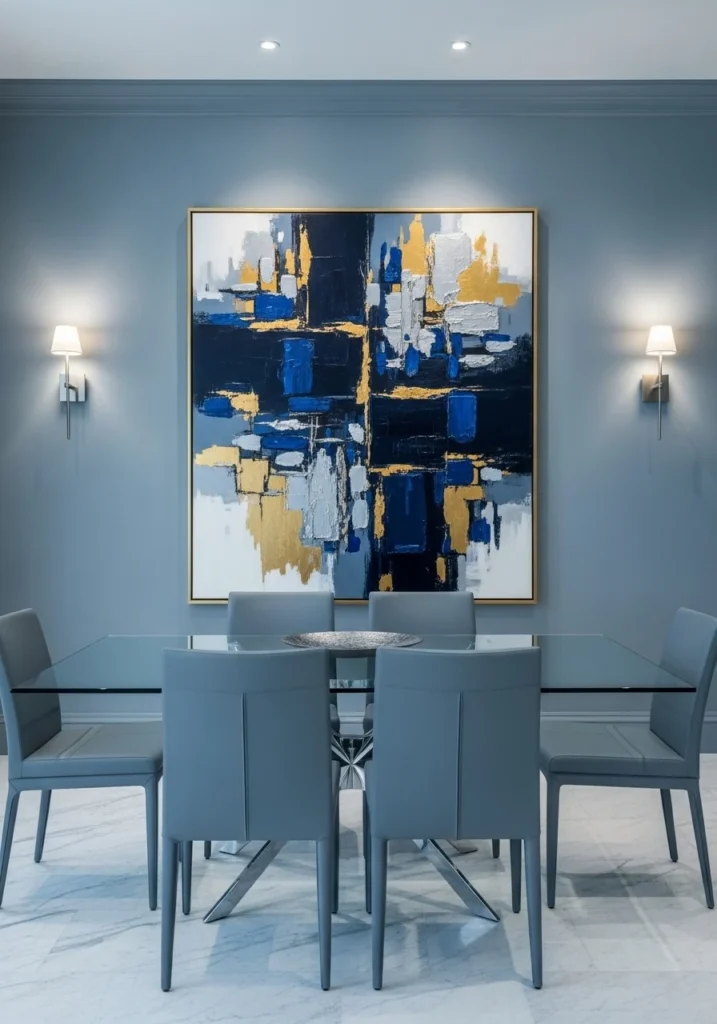
Paint dusty-blue plaster walls and hang oversized abstract paintings featuring navy and metallic accents. Use rectangular glass dining tables with leather chairs in muted blue tones.
Sometimes the best way to use blue is through carefully chosen artwork rather than overwhelming wall color—it gives you flexibility and sophistication.
7. Add Dimension Through Textured Wall Treatments
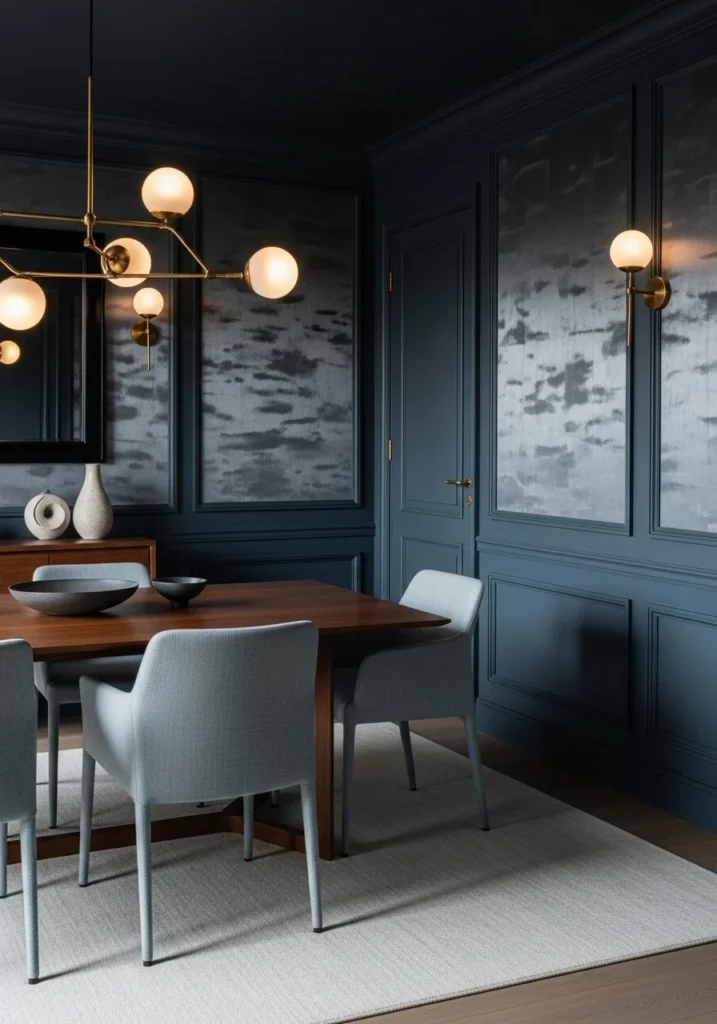
Install paneled indigo walls with subtle silk-effect wallpaper insets paired with sleek walnut tables and dove-blue linen chairs. Sculptural pendants with frosted globes provide soft lighting.
Texture prevents solid blue walls from feeling flat or painted-by-numbers. The dimensional quality adds luxury that paint alone cannot achieve.
8. Ground Your Space With Thoughtful Flooring
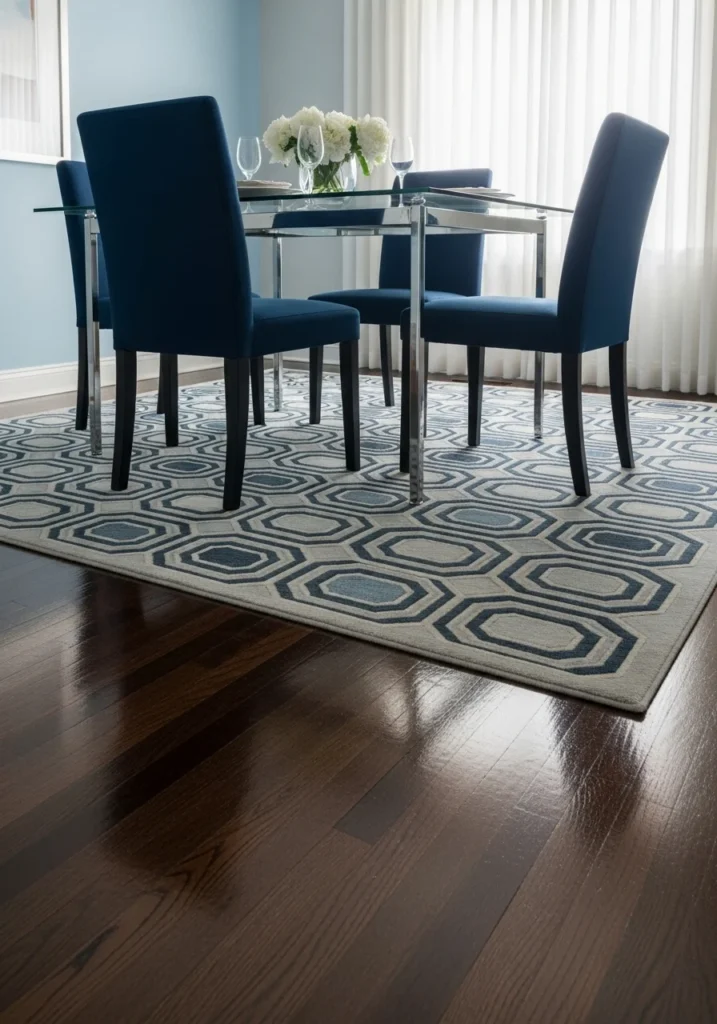
Use glossy dark hardwood floors layered with oversized designer rugs in blue-and-neutral geometric patterns. Pair with minimalist glass dining tables and navy chairs against pale blue accent walls.
The rug anchors your furniture while introducing pattern that makes the blue feel intentional rather than overwhelming.
9. Add Function With Styled Sideboards
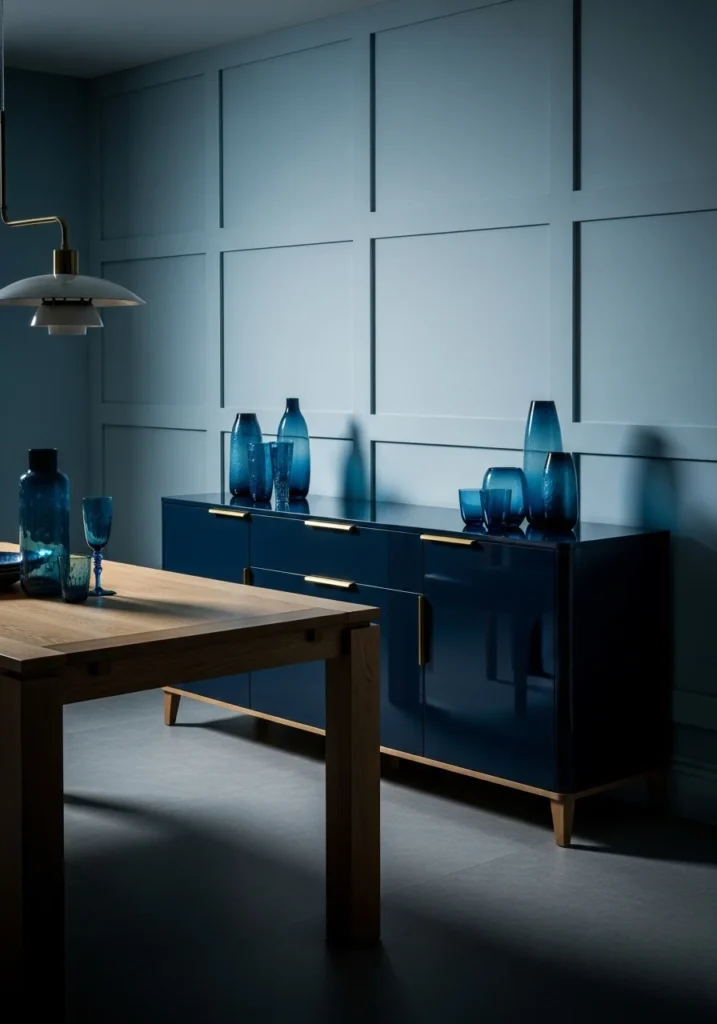
Choose sleek lacquered sideboards in navy gloss with brass handles, styled with blue-toned vases and glassware against pale sky-blue paneled walls.
The sideboard provides both storage and another opportunity to layer blue tones while brass hardware ties into other metallic accents throughout the room.
10. Create Focus With Statement Centerpieces
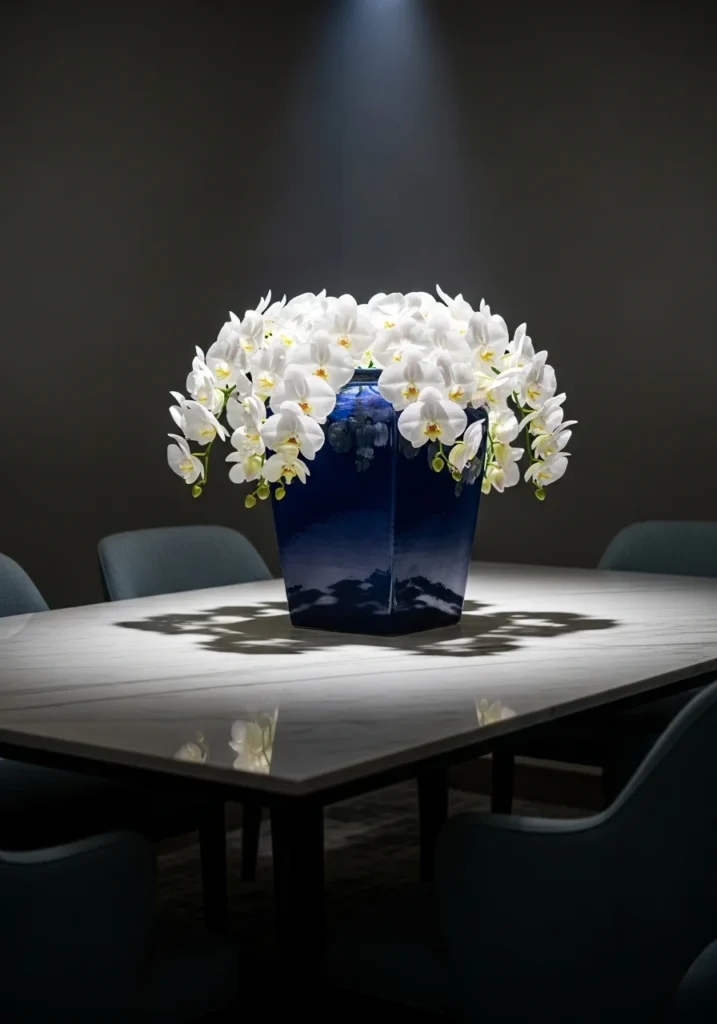
Style minimalist dining tables with oversized ceramic vases in deep blue filled with white orchids on marble tabletops. Surround with chairs in soft linen blue against moody walls.
Sometimes one perfect blue element creates more impact than trying to incorporate the color everywhere. Let your centerpiece be the star.
11. Perfect Your Atmosphere With Layered Lighting
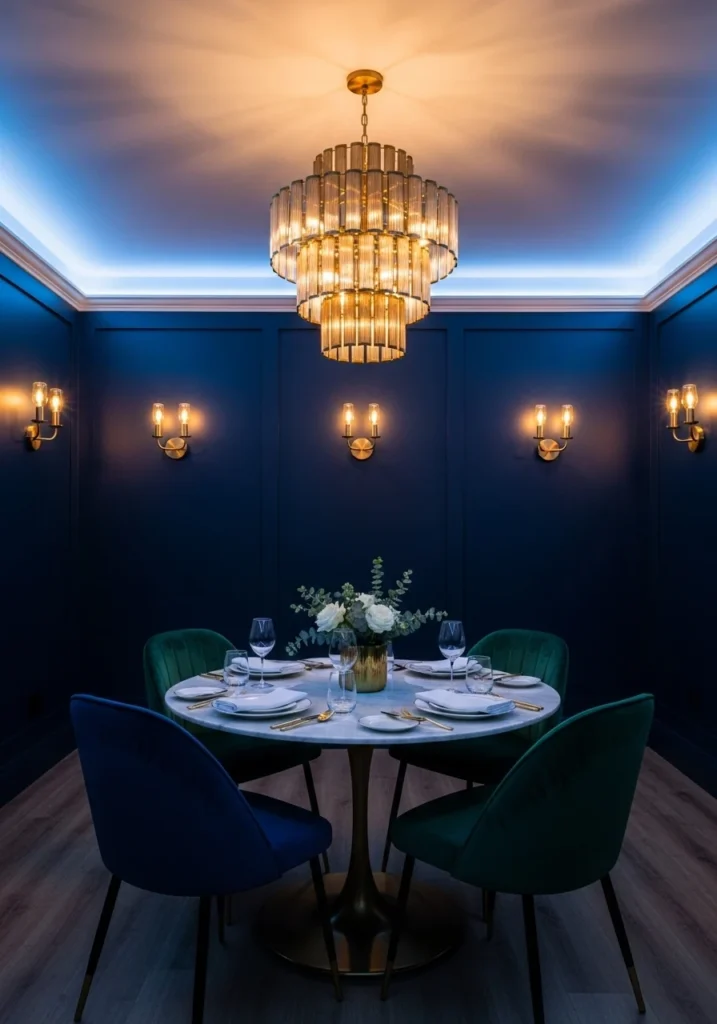
Combine navy walls with wall sconces casting warm glows, overhead brass chandeliers, and recessed ceiling LEDs for atmospheric lighting control. Use round marble tables with velvet chairs.
The interplay between warm and cool lighting prevents blue from feeling too cold or monotonous throughout different times of day.
12. Amplify Space With Reflective Surfaces
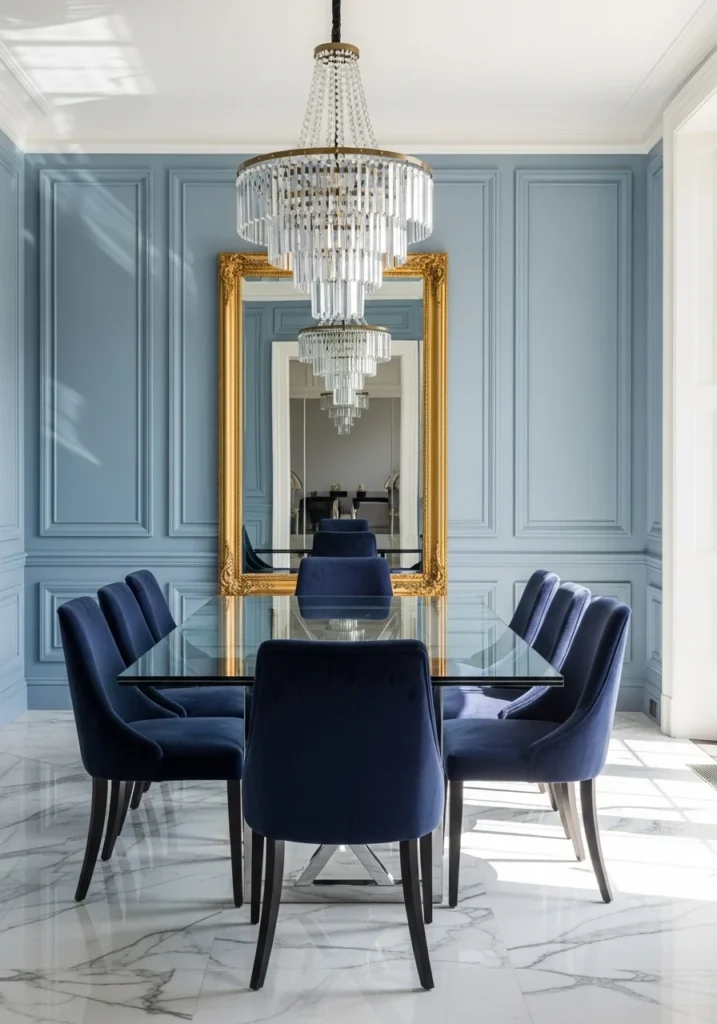
Use dusty-blue paneled walls with large gilded mirrors reflecting chandeliers. Glass dining tables amplify reflections while navy velvet chairs and marble floors enhance shine.
Mirrors and reflective surfaces prevent dark blue from making spaces feel smaller or enclosed—they bounce light and create openness.
13. Frame Your Space With Elegant Drapery
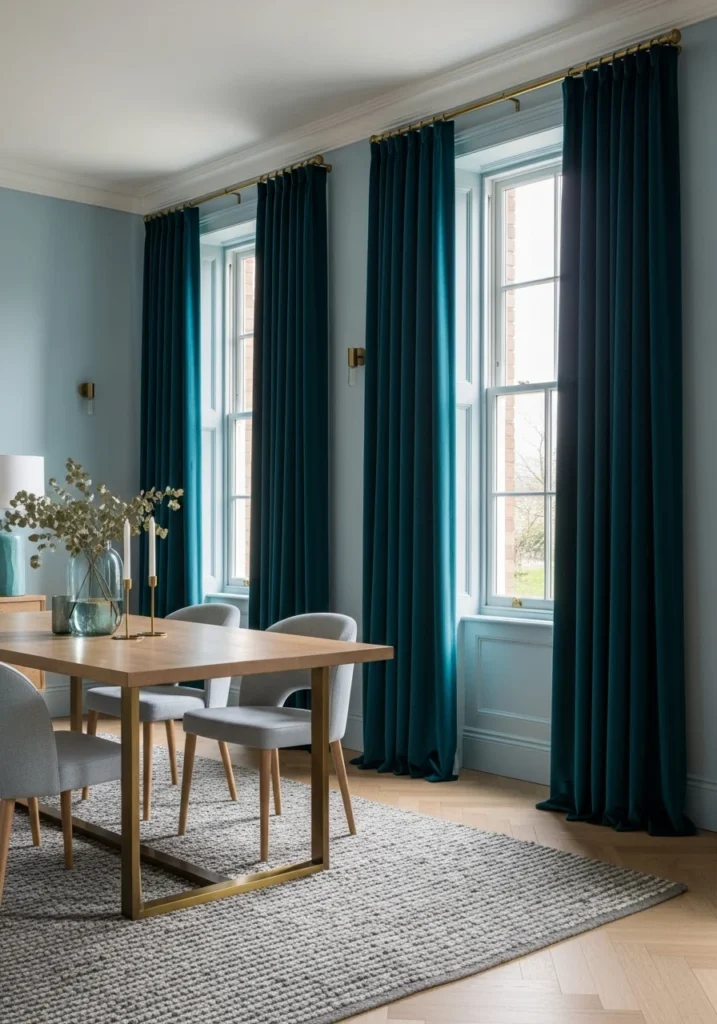
Install floor-to-ceiling velvet drapes in rich teal framing tall windows paired with soft powder-blue walls. Use oak tables with brass legs and pale grey-blue chairs.
The drapery adds softness and luxury while providing another opportunity to layer blue tones within your overall scheme.
14. Style Tables for Special Occasions
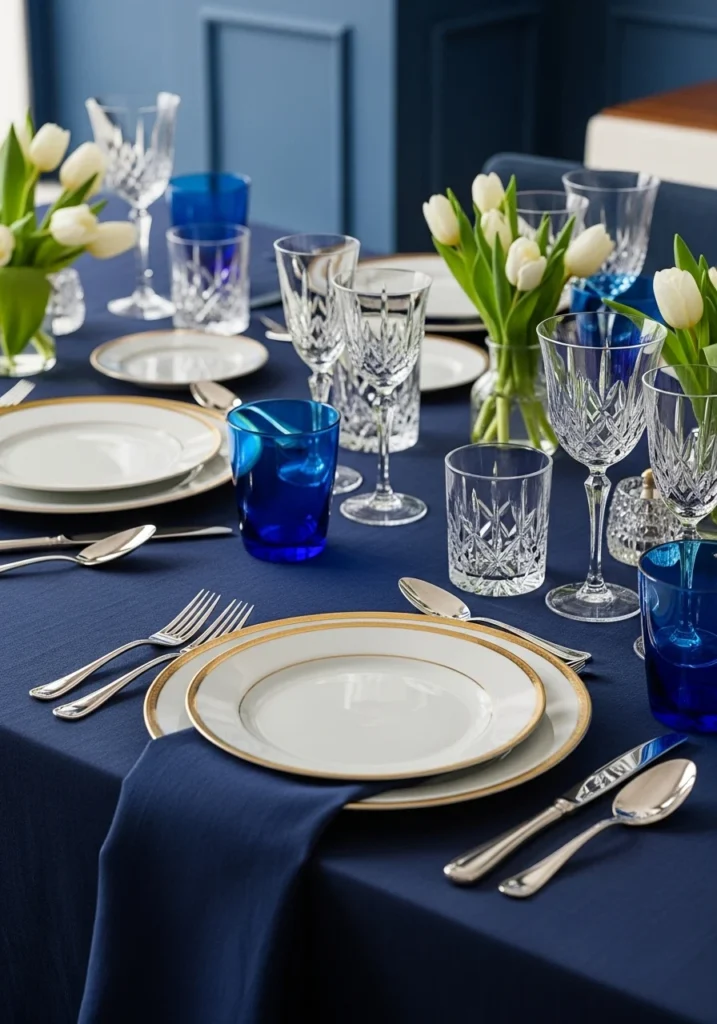
Use navy linen tablecloths with porcelain plates featuring gold rims, crystal glassware, and cobalt-blue water glasses. Add white floral accents against blurred indigo walls.
The table styling shows how blue can feel elevated and special for entertaining rather than everyday basic.
15. Balance Blue With Natural Elements
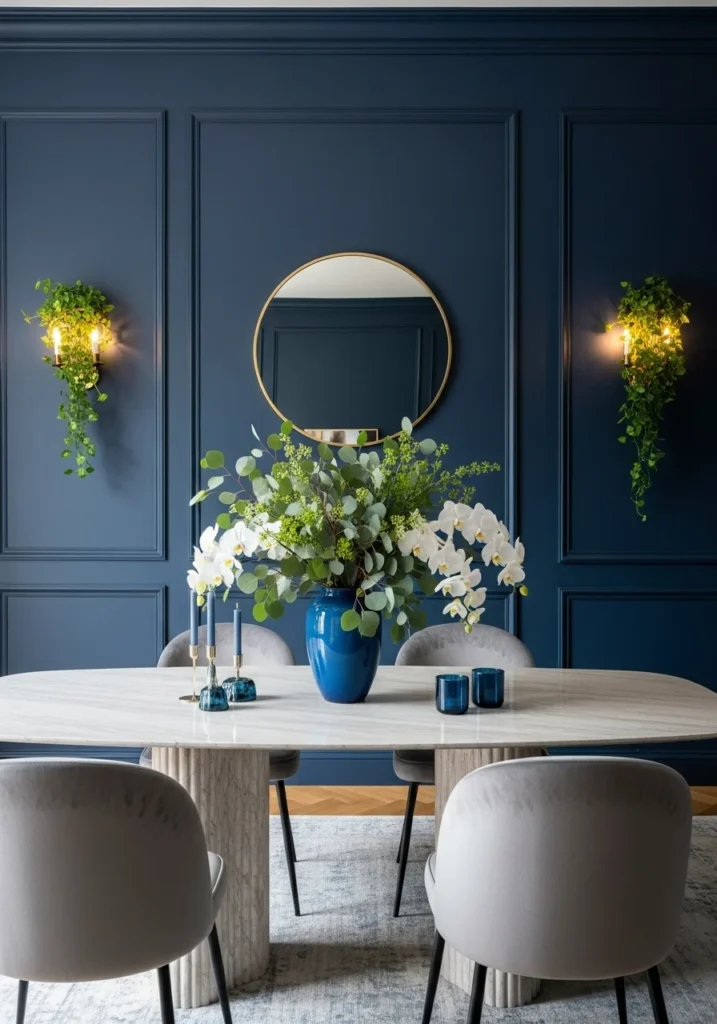
Paint deep navy walls and use pale marble tables with centerpiece arrangements of eucalyptus and orchids in cobalt vases. Add velvet chairs with soft rugs and wall sconces.
The greenery provides necessary organic contrast against blue’s intensity, preventing the space from feeling too designed or artificial.
Making Blue Feel Sophisticated
The difference between elegant blue dining rooms and ones that feel overwhelming usually comes down to restraint and balance. Don’t try to make everything blue—choose where you want the color to dominate and where you need breathing room.
Consider your lighting carefully. Blue can look completely different in natural versus artificial light, and in morning versus evening conditions. Test your shades throughout the day before committing.
Avoiding the Theme Room Trap
Blue dining rooms work best when the color feels like a sophisticated choice rather than a themed concept. Avoid obvious nautical or ocean references unless you genuinely love them—blue can stand alone without literal interpretations.
Layer different textures and materials to create depth. Velvet, silk, marble, brass, and wood all interact differently with blue tones, creating richness that prevents the space from feeling flat.
Choosing the Right Blue for Your Space
Consider your room’s natural light and size when selecting blue shades. Smaller rooms might benefit from lighter, dusty blues while larger spaces can handle deeper navy or cobalt without feeling oppressive.
Think about your lifestyle too. Darker blues hide wear better than lighter shades, but they also require more intentional lighting to prevent the space from feeling cave-like.
Final Thoughts
Creating a blue dining room that feels sophisticated rather than overwhelming requires understanding that blue is powerful and needs to be balanced thoughtfully. The best blue dining rooms layer different shades, incorporate quality materials, and provide enough neutral breathing room to let the color shine without dominating.
When your dining room makes people stop and admire the color choices rather than feel overwhelmed by them, when it photographs beautifully but also feels comfortable for everyday meals, you’ll know you’ve successfully captured that perfect balance of drama and livability that makes blue dining rooms so appealing.
